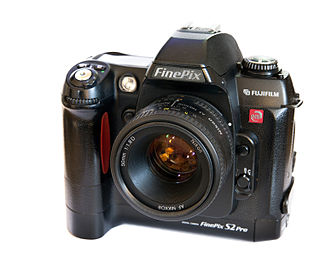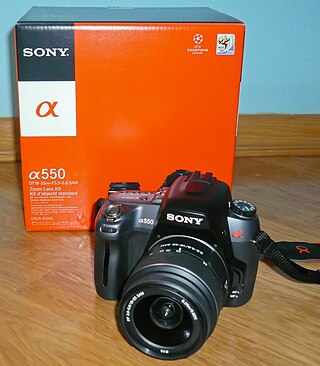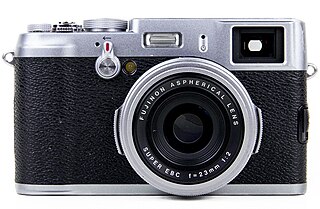
A digital camera, also called a digicam, is a camera that captures photographs in digital memory. Most cameras produced today are digital, largely replacing those that capture images on photographic film or film stock. Digital cameras are now widely incorporated into mobile devices like smartphones with the same or more capabilities and features of dedicated cameras. High-end, high-definition dedicated cameras are still commonly used by professionals and those who desire to take higher-quality photographs.

An autofocus (AF) optical system uses a sensor, a control system and a motor to focus on an automatically or manually selected point or area. An electronic rangefinder has a display instead of the motor; the adjustment of the optical system has to be done manually until indication. Autofocus methods are distinguished as active, passive or hybrid types.

A digital single-lens reflex camera is a digital camera that combines the optics and mechanisms of a single-lens reflex camera with a solid-state image sensor and digitally records the images from the sensor.
Super CCD is a proprietary charge-coupled device image sensor design that was developed by Fujifilm starting in 1999 and marketed with its digital cameras, starting with the FinePix 4700 and S1 Pro. Super CCD cameras were sold until 2010. The Super CCD uses octagonal, rather than rectangular, pixels. This allows a higher horizontal and vertical resolution to be achieved compared to a traditional sensor of an equivalent pixel count.

The FinePix S7000 is a 6.3 megapixel digital camera manufactured by Fujifilm. It was announced in July 2003, and has since been discontinued. It features 6x optical zoom.

A bridge camera is a type of camera that fills the niche between relatively simple point-and-shoot cameras and interchangeable-lens cameras such as mirrorless cameras and single-lens reflex cameras (SLRs). They are often comparable in size and weight to the smallest digital SLRs (DSLR), but lack interchangeable lenses, and almost all digital bridge cameras lack an optical viewfinder system. The phrase "bridge camera" has been in use at least since the 1980s, and continues to be used with digital cameras. The term was originally used to refer to film cameras which "bridged the gap" between point-and-shoot cameras and SLRs.

The Fujifilm FinePix S2 Pro is an interchangeable lens digital single-lens reflex camera introduced in January 2002. It is based on a Nikon F80 film camera body that was modified by Fujifilm to include its own proprietary image sensor and electronics. Because of the Nikon body, it has a Nikon AF lens mount and so can use most lenses made for Nikon 35 mm cameras. It is autofocusing, with an electronically controlled focal plane shutter with speeds from 30 sec. to 1/4000 sec., built-in exposure metering and pop-up flash. Its ISO film speed equivalents range from 100 - 1600. The S2 Pro also has sound recording capability. The camera is no longer in production, having been superseded by the Fujifilm FinePix S3 Pro in February 2004.

The Fujifilm FinePix S3 Pro is an interchangeable lens digital single-lens reflex camera introduced in February 2004. Its successor, the Finepix S5 Pro, was released on 25 September 2006. It is based on a Nikon F80 viewfinder, shutter, mirror-box and autofocus modules surrounded by a Fujifilm body that includes its own proprietary CCD image sensor and electronics, and a vertical grip shutter release. It has a Nikon F lens mount and can use most lenses made for 35 mm Nikon SLR cameras, but only with manual operation with Nikon AIS lenses, unusually for a digital SLR the S3 Pro can be used with a manual cable release.

The Sigma SD14 is a digital single-lens reflex camera produced by the Sigma Corporation of Japan. It is fitted with a Sigma SA mount which takes Sigma SA lenses.

Live preview is a feature that allows a digital camera's display screen to be used as a viewfinder. This provides a means of previewing framing and other exposure before taking the photograph. In most such cameras, the preview is generated by means of continuously and directly projecting the image formed by the lens onto the main image sensor. This in turn feeds the electronic screen with the live preview image. The electronic screen can be either a liquid crystal display (LCD) or an electronic viewfinder (EVF).

The Fujifilm FinePix S6500fd, known in the United States as S6000fd, was the first digital camera from Fujifilm with face detection technology. Also this camera has a different lens from its recent predecessors — a 28–300 mm equivalent 10.7x zoom, the same as the FinePix S9100/9600. The camera was announced on July 13, 2006.

The Panasonic Lumix DMC-GH1 is a digital mirrorless interchangeable lens camera adhering to the Olympus and Panasonic developed Micro Four Thirds System (MFT) system design standard. Panasonic classified the GH1 as a hybrid stills/video camera and the GH1 was introduced and marketed as a higher end camera than Panasonic's first MFT camera, the stills only, non-video capable Lumix DMC-G1.

The Fujifilm FinePix HS10 is an ultrazoom bridge camera from Fujifilm that was announced in February 2010. It is the first model of the Fujifilm FinePix HS series.

The Sony Alpha a550 (DSLR-A550) is a midrange-level digital single-lens reflex camera (DSLR) marketed by Sony and aimed at enthusiasts, it was released in August 2009. The camera features a 14.2 megapixel APS-C Type CMOS Exmor Sensor and features Sony's patented SteadyShot INSIDE stabilisation system which works with any attached lens. The Sony Alpha a550's main selling point is its dual Live View mode's, Sony's normal secondary; smaller sensor based Live View mode and another which uses the main sensor with no autofocus. The a550 also features a maximum of 7frame/s continuous shooting speed when operating in speed-priority mode and a maximum ISO of 1600 when in auto mode and 12800 ISO when in manual mode.

The Fujifilm X series is a line of digital cameras produced by Fujifilm. The series encompasses fixed lens and interchangeable lens mirrorless cameras and premium compact point-and-shoot cameras aimed at consumer, enthusiast and professional photographers. The X series is part of the larger FinePix range of digital cameras from Fujifilm.

The Fujifilm FinePix HS is a series of bridge cameras that started in February 2010 with the HS10 model. The special feature of the HS cameras is the manual zoom that - otherwise common only with system cameras - allows a quick and precise change of the focal length but demands two-handed operation.

The Fujifilm X100 is a series of digital compact cameras with a fixed prime lens. Originally part of the FinePix line, then becoming a member of the X series from Fujifilm, the X100 series includes the FinePix X100, X100S, X100T, X100F, X100V, and X100VI. They each have a large image sensor and a 23 mm lens. All six cameras have received generally positive reviews.

The Fujifilm FinePix HS50EXR is a DSLR styled ultra-zoom bridge camera announced by Fujifilm on January 7, 2013. It is the last model of the Fujifilm FinePix HS series. At the time of its release, it competed most closely with the Canon PowerShot SX50 HS, another ultra-zoom bridge camera with raw capability. The SX50 has 20% longer maximum effective focal length, but the HS50 has 33% more resolution on the sensor.

The Fujifilm X10 is a 2/3 sensor digital compact camera announced by Fujifilm on September 1, 2011. At the time of its release, it competed most closely with the Panasonic Lumix DMC-LX5, Olympus XZ-1, Canon PowerShot G1 X and Sony Cyber-shot DSC-RX100, and was subsequently named a 2013 iF product design award recipient.
















